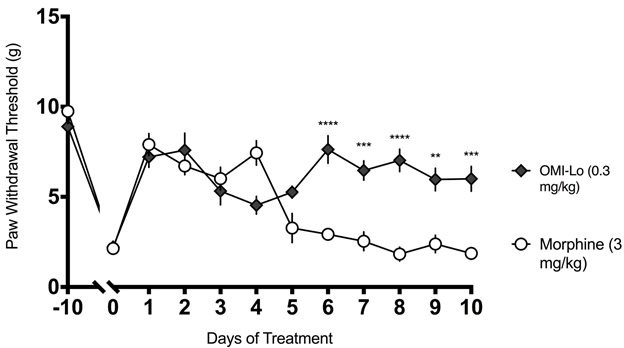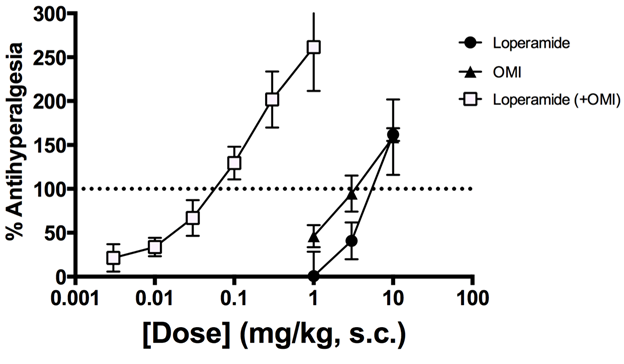Pain therapy without the risk of respiratory depression, addiction or abuse
An analgesic combination of peripherally restricted opioids that eliminates the risk of respiratory depression, chemical addiction or abuse.



The costly problem of pain
It is estimated that up to 100 million Americans live with moderate to severe pain as a result of disease or injuries. Opioid-based analgesics are the gold standard for pain treatment. However, the long-term use of these analgesics carries significant risk for lethal respiratory depression, tolerance, addiction and diversion. Approximately 25% of patients prescribed opioids for chronic pain misuse them at an estimated economic burden of $78.5 billion annually. There is a significant unmet need for pain management modalities without this social-economic burden. Opioid receptors reside in both the central and peripheral nervous system and risks associated with opioid analgesics are primarily due to actions within the central nervous system. There have been several strategies employed to avoid these risks, including: (1) slow-release opioid analgesics, (2) combining drugs that activate opioid receptors (agonists) with drugs that block opioid receptors (antagonists), (3) adding abuse-deterring compounds to the formulation, and (4) using opioid agonists that do not enter the brain. Unfortunately, these approaches have failed to provide effective pain management that truly eliminates the risk of addiction.
Finding relief
University of Minnesota researchers Dr. George Wilcox and Dr. Carolyn Fairbanks have developed a novel method for treating pain by administering a peripherally restricted μ-opioid analgesics in combination with a δ-opioid receptor analgesic. Combining loperamide, a highly efficacious μ-opioid receptor agonist that is excluded from the central nervous system, and oxymorphindole, a δ-opioid receptor agonist that was shown to synergize with morphine spinally, elicits an analgesic effect in inflamed animals at doses as much as 150 times less than administration of either compound alone. Restriction of the μ-opioid agonist to the peripheral nervous system eliminates the respiratory depression and abuse/addiction potential associated with opioid-based analgesics that gain access to the CNS. Furthermore, while the compounds behave synergistically in relation to their analgesic properties, their combination does not multiply observed side effects, which results in a therapeutic treatment window that is 5-50 times larger than either compound used alone. Taken together the loperamide-oxymorphindole combination is a promising pain intervention with a significantly diminished risk profile.
Phase of Development
TRL: 4-5. In vivo animal data.Features & Benefits
- Non-addictive pain management: Use of μ-opioid compound that is restricted from entering the CNS eliminates the development of chemical dependence.
- Highly-potent analgesic: Synergism between μ- and δ-opioid receptor agonists leads full analgesic effects at doses as much as 50 times less than their use alone.
- Minimal side effects and low dosing: The greatly increased analgesic potency does not generalize to the side effects, so that the use of both agonists together results in a therapeutic window 5-50 times larger than either alone.
- No development of opioid tolerance: The greatly reduced doses of the two analgesics allows repeated dosing without the development of opioid tolerance.
Applications
- Non-addictive post-operative pain management
- Chronic and cancer related pain management
- Prescription or OTC medication
- Long-term dosing for chronic pain without the development of opioid tolerance
Researchers
- George Wilcox, PhD Professor, Dept. of Neuroscience
- Carolyn Fairbanks, PhD Associate Dean for Research and Professor, Dept. of Pharmaceutics
- Philip Portoghese, PhD Distinguished Professor, Dept. of Medicinal Chemistry
- Eyup Akgün, PhD Research Associate Professor, Dept of Medicinal Chemistry
Desired Partnerships
This technology is now available for:- License
- Sponsored research
- Co-development
Please contact our office to share your business’ needs and learn more.
-
expand_more library_books References (2)
- Bruce, Daniel J., Cristina D. Peterson, Kelley F. Kitto, Eyup Akgün, Sophia Lazzaroni, Phillip S. Portoghese, Carolyn A. Fairbanks, and George L. Wilcox (Sep 2019), Combination of a δ-opioid receptor agonist and loperamide produces peripherally-mediated analgesic synergy in mice, Anesthesiology, 131, 649–663
- Griffith, J.I., Kim, M., Bruce, D.J., Peterson, C.D., Kitto, K.F., Mohammad, A.S., Rathi, S., Fairbanks, C.A., Wilcox, G.L. and Elmquist, W.F. (2022), Central Nervous System Distribution of an Opioid Agonist Combination with Synergistic Activity., Journal of Pharmacology and Experimental Therapeutics, 01, 34-36
-
expand_more cloud_download Supporting documents (1)Product brochurePain therapy without the risk of respiratory depression, addiction or abuse.pdf